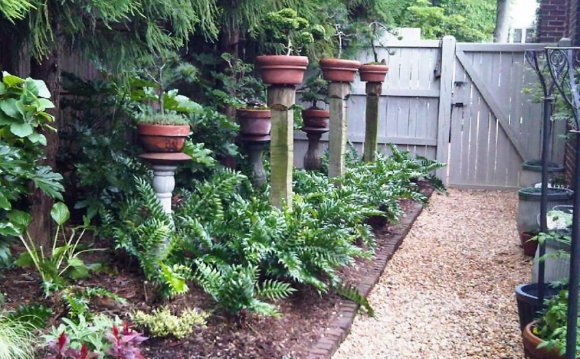
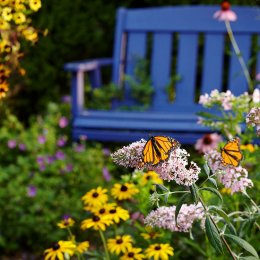
Balance
As you consider balance in landscape design, think of plants and objects in the garden as having visual weight. Some items are tall and square, others are billowing and round. When you have balance in a garden setting, you have equilibrium between all the parts when they're viewed from a particular angle. The balance may seem to disappear when you move to another position in the garden, but it remains. When there's balance, the garden exudes a feeling of harmony and stability.
Imagine a central axis running through the center of the space. Distribute the visual weight of the objects in the planting bed equally on opposite sides of that axis, and you achieve balance.
For instance, if on one side of the planting bed you have a false indigo that is 36 inches tall and wide, you'll want to balance that with something of a similar visual weight on the opposite side.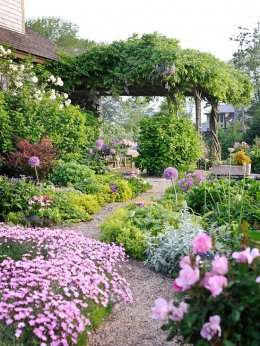 You might use a tuteur with a vine, or even a pair of smaller plants that create a similar bulk, such as aster and lady's mantle. The net effect is that when you step back and view the bed, there's an object on the left with a particular visual weight and it's balanced by an object on the right.
You might use a tuteur with a vine, or even a pair of smaller plants that create a similar bulk, such as aster and lady's mantle. The net effect is that when you step back and view the bed, there's an object on the left with a particular visual weight and it's balanced by an object on the right.
To achieve balance, don't try too hard. If you concentrate on achieving balance, the look will be formal and possibly contrived. Aim to create a landscape design that's pleasing to your eye.
Contrast
Sometimes called variety, contrast is probably the easiest concept for gardeners to grasp. After all, it's an cinch to gather a collection of plants that catch your eye. Achieving effective contrast involves mingling those plants in a pleasing manner. For instance, if you plant daylily, ornamental grass, and a sedge together, while you have a variety of plants, you don't have contrast because they all have grasslike foliage and a similar form.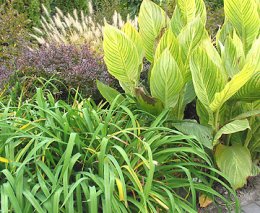 If you replace the sedge with an upright sedum and include a lady's mantle, you have a grouping that unfurls contrast through the growing season, adding drama to the garden.
If you replace the sedge with an upright sedum and include a lady's mantle, you have a grouping that unfurls contrast through the growing season, adding drama to the garden.
Introduce contrast through plants using texture, height, form, and color. You also can rely on hardscape elements to punctuate a perennial garden with texture. A steel-frame trellis, a stone bench, a lively stepping-stone path - each offers a different texture, be careful not to overdo the contrast. When contrast rules in a garden, the result is chaos. Balance contrast with repetition.
Repetition
Repetition in landscape design creates cohesiveness. It's the subtle sign, maybe only registered subconsciously, that separate parts of the garden or yard are part of the whole.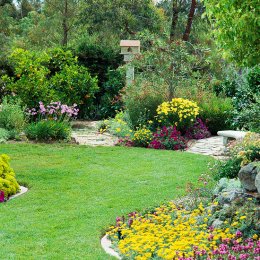 You can repeat plants, using the same species or variety at several points in your planting bed, or you can repeat aspects of plants, such as color, texture, line, or form. Color is one of the strongest motifs in effective repetition, striking balance and cuing the eye that separate parts of the garden are connected. Yellow blooms connect the garden at right. You also can create repetition through objects or hardscape materials.
You can repeat plants, using the same species or variety at several points in your planting bed, or you can repeat aspects of plants, such as color, texture, line, or form. Color is one of the strongest motifs in effective repetition, striking balance and cuing the eye that separate parts of the garden are connected. Yellow blooms connect the garden at right. You also can create repetition through objects or hardscape materials.
Rhythm
When you incorporate rhythm in a landscape design, you insert flow and movement. It's not the plants or the garden itself moving, but rather the eye of the person viewing it. When rhythm is at work, the eye is drawn neatly through a garden, following the repetition of plants, colors, or objects or flowing along a path or a series of terraces.
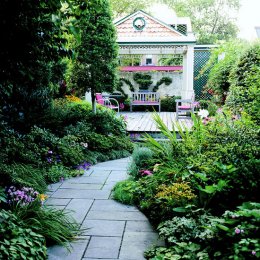 Arranging plants in a bed from tallest in back to shortest in front creates movement. Using plants that sway in the breeze, like ornamental grasses, sedges, or New Zealand flax, also generates rhythm. Interrupting a bed of low-growing perennials, such as pinks or groundcover sedum, with a tall clump of penstemon or Siberian iris or a stone sculpture, creates a sense of movement because the eye has to travel around the interruption. Pathways, whether curved or straight, introduce rhythm. A curved path can physically cause a viewer to move in the garden to explore what lies around the bend.
Arranging plants in a bed from tallest in back to shortest in front creates movement. Using plants that sway in the breeze, like ornamental grasses, sedges, or New Zealand flax, also generates rhythm. Interrupting a bed of low-growing perennials, such as pinks or groundcover sedum, with a tall clump of penstemon or Siberian iris or a stone sculpture, creates a sense of movement because the eye has to travel around the interruption. Pathways, whether curved or straight, introduce rhythm. A curved path can physically cause a viewer to move in the garden to explore what lies around the bend.
Focal Point
A focal point is the first place your eye lands when taking in a scene. Landscape focal points can be plants or structures. Perhaps you have a pleasing arbor or a garden shed that you would like to highlight as a focal point. If you select a plant as a focal point, be sure that it stages strong interest throughout the growing season.
Once you decide where to place your focal point, design the rest of the landscape in relationship to it. Draw an imaginary line through the focal point in several directions to determine where to place other key plants or objects in your garden that will support and direct views toward the focal point. These become the axes of the garden. As you play with form and line around and along these axes, you will create a garden masterpiece.















